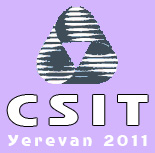
 | |||||
Armenia is a country of high mountains, forestry canyons, gurgling springs and flowering meadows. This land of ancient culture, old legends and Biblical stories is often called an open-air museum.
Christianity in Armenia began since the times when Christ's Apostles St. Thaddeus and Bartholomew preached in Armenia around 100 AD. St. Grigor the Illuminator was tortured and imprisoned by the King Trdat for his attempts to establish Christianity.
 Armenians
are among oldest and most distinct ethnic groups, having inhabited
the area east and south of the Black Sea since the seventh century BC. Both
the Armenian alphabet and the Armenian church date back to the fourth century
and remain substantially unchanged today. Ancient Armenia has left a legacy
of many gifted artists, writers, and philosophers. Armenians
are among oldest and most distinct ethnic groups, having inhabited
the area east and south of the Black Sea since the seventh century BC. Both
the Armenian alphabet and the Armenian church date back to the fourth century
and remain substantially unchanged today. Ancient Armenia has left a legacy
of many gifted artists, writers, and philosophers.
Since 11th century Armenia lost its independence and for centuries remained under the rule of other states. In 1918 Armenia declared its independence by forming the first Republic on May 28. For 70 years, beginning from 1920, Armenia had been one of the Soviet Republics. In 1991 Armenia regained independence, becoming a Presidential Republic. The present Constitution of Armenia was adopted on July 5, 1995. Armenia joined the CIS in March 1992 and CIS Defence Treaty in May 1992. Armenia is situated in the South-western Asia, has aterritory of 29.800 sq. km. and altitudes 1000 to 2500 m above the sea level. Its climate ranges from dry subtropical to cold mountain weather. The information about current weather in Yerevan, Armenia could be obtained from one of the following sources:
As of 1999 data, the population of Armenia is 3.7 mln., with 1.2 mln. living in Yerevan. Armenia's geographical location is very convenient for connections with all the countries of Europe, Middle East, Asia, and CIS countries. The national currency of
Armenia is Dram.
|
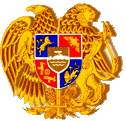
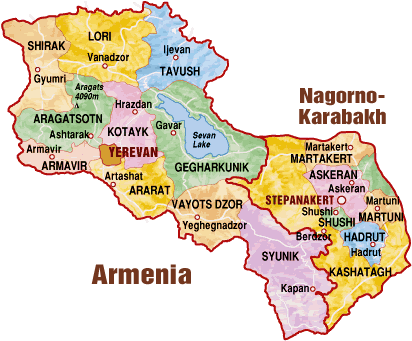 Armenia's
history dates back to the third millennium BC. The Armenian upland is considered
as one of the cradles of human civilization. Primitive stone tools, made about
half a million years ago are found at the foothills of Mt. Aragats and in the
canyon of River Hrazdan. The country was mentioned in the Bible as the Armenian
Kingdom, Urartu, and shown among six countries on the Babylonian clay
tablet (5th century BC).
Armenia's
history dates back to the third millennium BC. The Armenian upland is considered
as one of the cradles of human civilization. Primitive stone tools, made about
half a million years ago are found at the foothills of Mt. Aragats and in the
canyon of River Hrazdan. The country was mentioned in the Bible as the Armenian
Kingdom, Urartu, and shown among six countries on the Babylonian clay
tablet (5th century BC).
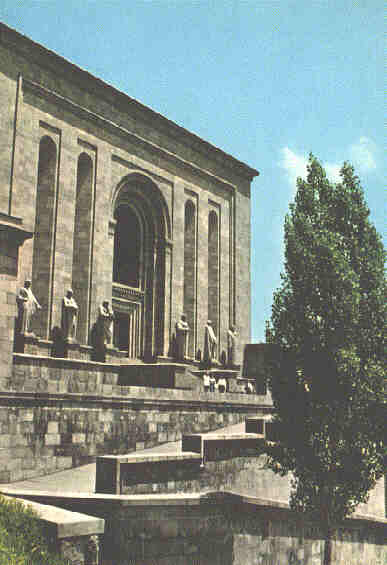

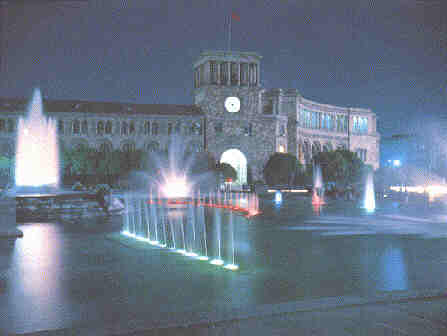 Today
a walk through Yerevan will reveal the splendor of the city's architecture in
its multicolored tufa stone buildings and beautiful gurgling fountains, which
are a special feature of the city. The large cascade of fountains in the
city's center at Republic Square are known as the Singing Fountains and are
lit in different colors and accompanied by music to which the water dances and
plays. Republic Square is in the center of the city and is dominated by government
buildings. Yerevan is a city of parks, wide streets and spacious squares.
Today
a walk through Yerevan will reveal the splendor of the city's architecture in
its multicolored tufa stone buildings and beautiful gurgling fountains, which
are a special feature of the city. The large cascade of fountains in the
city's center at Republic Square are known as the Singing Fountains and are
lit in different colors and accompanied by music to which the water dances and
plays. Republic Square is in the center of the city and is dominated by government
buildings. Yerevan is a city of parks, wide streets and spacious squares.
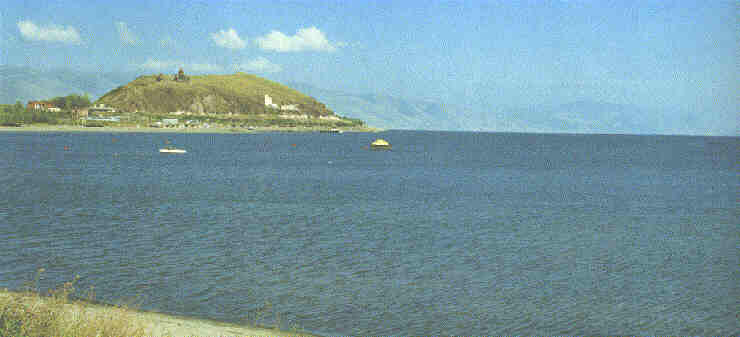 Lake
Sevan, an hour and half drive outside of the Yerevan city, is the largest
lake in the region. The lake is situated 2,000 meters above sea level. The lake's
sandy beaches and pure cool water receive an abundance of sunshine providing
excellent conditions for swimming and sun bathing.
Lake
Sevan, an hour and half drive outside of the Yerevan city, is the largest
lake in the region. The lake is situated 2,000 meters above sea level. The lake's
sandy beaches and pure cool water receive an abundance of sunshine providing
excellent conditions for swimming and sun bathing.